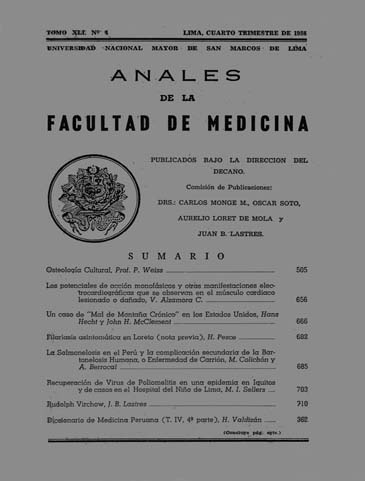Monophasic action potentials and electrocardiographic manifestations observed in injured or damaged heart muscle - Experimental work
DOI:
https://doi.org/10.15381/anales.v41i4.8964Abstract
By various methods has been possible to obtain all of monophasic action potential in accordance with the theory of the membrane were theoretically predictable. In an injured area resting potential of the membrane may remain unchanged, being zero or supernormal subnormal. Consequently they can register monophasic action potential currents without damage, or injury caused by streams or hipopolarización membrane hyperpolarization. The only essential requirement to record monophasic action potentials is blocking the excitation, the current of injury is a phenomenon that attachment may or may not be present. When the heart muscle is severely injured the excitation process is blocked and then monophasic action potentials are inscribed. By decreasing the damage processes depolarization and repolarization are performed slowly and then enroll QRS-T complex and large widths. When the deterioration is less excitation process is done faster. Experiments suggest the existence of a correlation between the degree of market harm or damage and the degree of blocking cardiac excitation fiber. The sequence of changes in the electrocardiogram in cases in which there was uniform damage, severe but reversible, can explain the genesis of abnormal curves recorded at exploring unevenly worn or damaged muscle areas. In this form the meaning of abnormal electrocardiogram that is recorded in daily clinical practice in different circumstances is required.Downloads
Published
1958-12-31
Issue
Section
Trabajos originales
License
Copyright (c) 1958 V. Alzamora Castro

This work is licensed under a Creative Commons Attribution-NonCommercial-ShareAlike 4.0 International License.
Those authors who have publications with this magazine accept the following terms:
- Authors will retain their copyrights and guarantee the journal the right of first publication of their work, which will be simultaneously subject to Creative Commons Attribution License that allows third parties to share the work as long as its author and its first publication this magazine are indicated.
- Authors may adopt other non-exclusive licensing agreements for the distribution of the version of the published work (eg, deposit it in an institutional electronic file or publish it in a monographic volume) provided that the initial publication in this magazine is indicated.
- Authors are allowed and recommended to disseminate their work over the Internet (eg: in institutional telematic archives or on their website) before and during the submission process, which It can produce interesting exchanges and increase quotes from the published work. (See El efecto del acceso abierto ).
How to Cite
1.
Alzamora Castro V. Monophasic action potentials and electrocardiographic manifestations observed in injured or damaged heart muscle - Experimental work. An Fac med [Internet]. 1958 Dec. 31 [cited 2024 Aug. 16];41(4):656-65. Available from: https://revistasinvestigacion.unmsm.edu.pe/index.php/anales/article/view/8964















